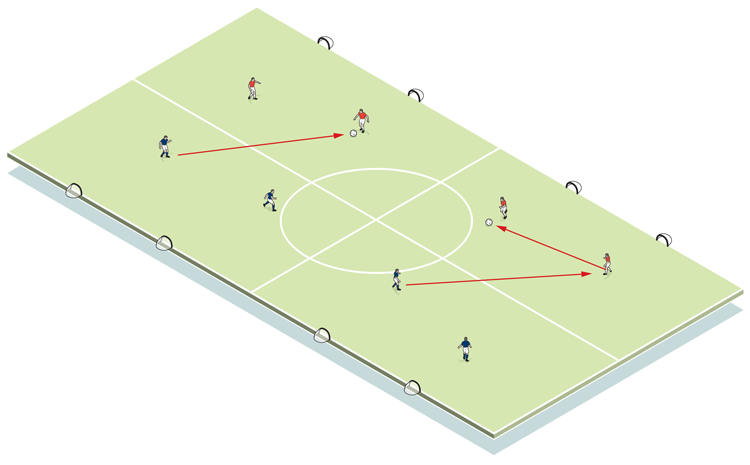You are viewing 1 of your 1 free articles
Midfield as a defensive unit
Use this session to get your midfield working as a defensive unit. It’s important to practise this because players in the midfield unit need to develop a clear understanding of their defensive roles. They must learn to be an effective bank without, as well as with, the ball.
| Area | Third of a pitch |
| Equipment | Balls, cones, mini-goals (or poles) |
| No. of Players | Up to full squad |
| Session Time | 10mins per game |
This session is about the midfield working as a defensive unit. It’s important to practise this because players in the midfield unit need to develop a clear understanding of their defensive roles. They must learn to be an effective bank without, as well as with, the ball.
The session is usually set up on the midfield third of the pitch, using eight mini-goals (or poles).
What do I get the players to do?
2v2s (1)
We begin with two 2v2s played alongside each other. Blues begin the practice by playing the ball into reds. Their target is to score into one of the two goals. Blues must defend well in order to prevent this.
1

What are the key things to look out for technically/tactically?
Each player is responsible for his opposite man – the player in that ‘slot’ is the player to press. Attention must be paid to body shape, and each man must decide quickly whether to show the opponent inside or outside.
Cover for the first defender to move out is essential (as you would do a centre-back in a game), and if play is switched then players must press the ball quickly and positively.
4v4s (2)
We now progress to a 4v4 by removing the central line. While the game is wider, the principles are the same, namely that each player must press his opposite man in ‘the slot’, and body shape is essential. Other defenders must stay compact, and players will need to show they know when to squeeze (the opponent being closest to them) and when to cover position (the opponent engaged with a team mate).
2

How do I progress the game?
We now add in two strikers at each long side, as shown. (3) These are here to play off, giving another requirement for defenders – namely to work hard screening the ball into the strikers as well as covering the goals and each other.
3

Attacking waves (4/5)
The final game sees us extend the area by an extra 30 yards. Defending is now done by two banks of four, but attacking teams working in fours also have two central strikers to play into, as shown.
The first defensive line here is key, as this shows midfielders defending. The intention is that a pass should never make it through to the front two strikers, but if it does, the back four can clear the danger.
At the end of each attack, two players from the offensive line of four replace the two strikers; all other attackers leave the pitch. A new line of four attackers now comes in and the attack is restarted. We repeat this so as to ensure constant waves of attack.
4

5

Related Files
Editor's Picks
Using the goalkeeper in build-up play
Pressing principles
Intensive boxes drill with goals
Penetrating the final third
Creating and finishing
My philosophy
Pressing initiation
Compact team movement
Defensive organisation
Coaches' Testimonials

Alan Pardew

Arsène Wenger

Brendan Rodgers

Carlos Carvalhal

José Mourinho

Jürgen Klopp

Pep Guardiola

Roy Hodgson

Sir Alex Ferguson

Steven Gerrard
Related
High press
Sunflower positioning
Out of possession match preparation
Coaches' Testimonials

Gerald Kearney, Downtown Las Vegas Soccer Club

Paul Butler, Florida, USA

Rick Shields, Springboro, USA

Tony Green, Pierrefonds Titans, Quebec, Canada
Join the world's leading coaches and managers and discover for yourself one of the best kept secrets in coaching. No other training tool on the planet is written or read by the calibre of names you’ll find in Elite Soccer.
In a recent survey 92% of subscribers said Elite Soccer makes them more confident, 89% said it makes them a more effective coach and 91% said it makes them more inspired.
Get Monthly Inspiration
All the latest techniques and approaches
Since 2010 Elite Soccer has given subscribers exclusive insight into the training ground practices of the world’s best coaches. Published in partnership with the League Managers Association we have unparalleled access to the leading lights in the English leagues, as well as a host of international managers.
Elite Soccer exclusively features sessions written by the coaches themselves. There are no observed sessions and no sessions “in the style of”, just first-hand advice delivered direct to you from the coach.









